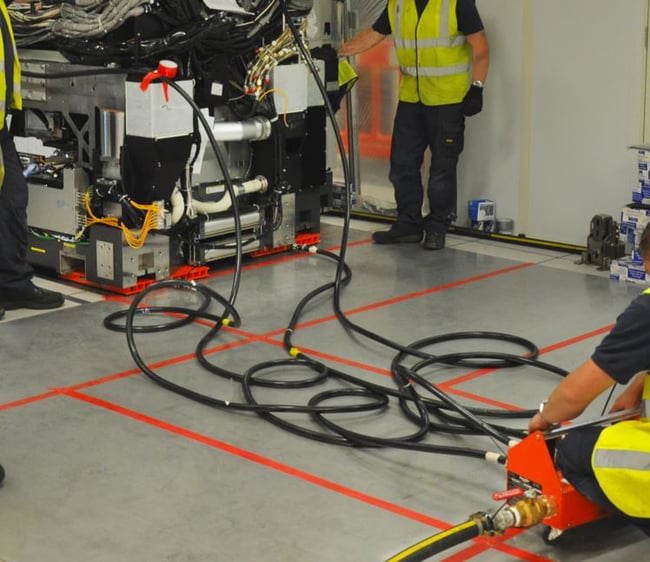Whether you’re transporting high-value equipment within a cleanroom environment, positioning delicate scientific instruments, or aligning heavy tools, traditional moving skates often lack the level of precision, accuracy and care that you need.

Air skates—also known as air casters—are upgrading the way we handle precision movement.
In this article, we explore how air skates work, and the key benefits and challenges of using them for your sensitive, business-critical equipment.
The Problems with Traditional Moving Skates
While traditional moving skates can handle heavy loads, they aren’t always ideal for moving sensitive, high-technology equipment like scanning electron microscopes (SEMs).
This is because they often involve contact with wheeled skates, lifts and cranes, which cause friction, stress loads and vibrations that compromise the precision and efficiency of some equipment.
At the same time, traditional skates are one-directional and require steering mechanisms just to help them change direction. And because removal routes are often indirect, that means you’ll likely have to remove or shut down any pieces of equipment that are in the way, causing cascading delays for production and significantly impacting your bottom line.
There’s a better way to move complex, sensitive equipment.
Introducing: Air Skates
Air skates are specialised equipment used for moving heavy loads with minimal friction.
They essentially work in the same way as an air hockey table—though on a much larger and more precise scale.
Using the principle of fluid dynamics, these systems create a thin cushion of air between the load and the ground, reducing friction to ultra-low levels and giving movers a lot more control over direction.
To do this, they consist of multiple air pads or air bearings located underneath the load. These pads are connected to an air supply system, typically through hoses. The air supply system pumps compressed air into the air pads, creating a thin film of air between the pads and the floor.
This air cushion acts as a lubricating layer, reducing friction and allowing the load to hover slightly above the ground.
The Benefits of Using Air Skates
Air skates are the answer to many of the challenges presented by traditional moving skates.
Here are some of the key benefits of using them to move your sensitive equipment.
1. Precision Movement
Air skates offer exceptional control when moving heavy equipment.

While traditional skates are one-directional and require pivoting steering mechanisms or adjustments to change direction, air skates are multidirectional. That means you can push equipment in any direction with less effort and better accuracy. Operators can also adjust the air pressure in the cushions to control the speed and direction of the load with ease.
This means you not only have much greater control over the movement of your equipment, but you can also steer around any pieces that might be in the way, eliminating the need to de-install or remove them.
2. Reduced Friction
Traditional moving skates require constant contact with the ground, creating high levels of friction and vibrations. These can be extremely damaging to sensitive equipment and negatively impact the way that they function.
Air skates greatly minimise the risk of damage from friction or vibrations, as they enable you to move equipment without the friction caused by rigid wheels or contact with the ground.
3. Weight Distribution
Traditional moving skates distribute the weight of the load unevenly, with most of the weight concentrated on the wheels or rollers. This uneven distribution can cause damage to both the equipment being moved and the flooring underneath.
Air skates evenly distribute the weight of the load across the entire surface area of the air cushions. This prevents damage to the equipment and flooring.

4. Safety
Moving heavy equipment poses significant safety risks to workers.
Air skates reduce the need for manual lifting and effort in pushing—minimising the potential for any accidents and injuries. For example, with air skates, it takes only 5kg of force to push 1 ton of weight.
The Challenges of Using Air Skates
No method of moving equipment comes without its challenges. And air skates are no exception.
Here are some of the key considerations you should be aware of.
1. Angles
Angles affect the force needed to move the tool.
It can be very difficult to move the equipment you’re moving up even a few degrees, and dangerous for your engineers to try to keep the tool from running away on a decline.
Because of that, we recommend thoroughly assessing your path for angles and inclines before starting and carefully planning how you’re going to deal with those. In cases where you’re working with a steeper incline, you also might want to use additional support equipment such as ramps or wedges.
2. Gaps and Voids
Air volume provides the pressure needed to traverse a crack in concrete or small expansion joints.
But larger gaps and voids in the ground can cause the air skates to drop and stick.
So, before attempting to move a load over a section of flooring with gaps or voids, it’s essential that you identify the locations of these gaps and measure their width, depth, and length to assess the extent of the challenge.
For smaller gaps or voids, you can consider using bridge plates or ramps to create a smoother transition for the load. It’s important to ensure that these bridge plates are securely in place and can support the weight of the load.
3. Damage
A loose screw or another sharp hazard could easily damage the air cushion diaphragm in transit and cause it to leak or rupture.
The diaphragm is essentially a purpose-built bag with holes in the bottom, which is placed under the tool and pressurised with air to provide a cushion between the tool and the ground.
If it were to start leaking, this could cause the diaphragm to drop and stick. A sudden rupture, on the other hand, could be far more catastrophic, causing the bladder to burst and the tool to drop suddenly.
Using air skates requires careful planning and consideration to ensure that your intended path is reasonably smooth, flat and without any items that can damage the air diaphragm.
Move Sensitive Equipment with Confidence
Need to move sensitive, business-critical equipment? Put your trust in our team of expert engineers and movers.
We’ve been moving sensitive equipment since 1991, working with businesses in high-technology industries like semiconductor, pharmaceutical and aerospace.




